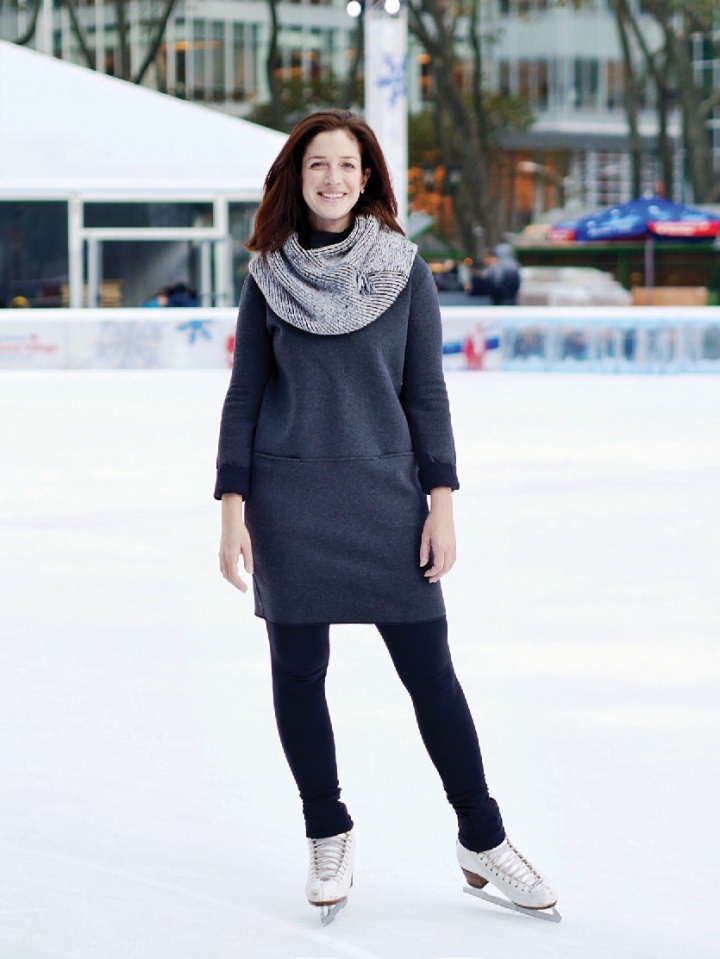Columbia College | Columbia University in the City of New York
Ashley Walker Green ’05 Has the Moves on the Ice
Figure skating coach Ashley Walker Green ’05 can pinpoint the exact moment she became captivated by her sport: The year was 1988 and she was watching gold medalist Katerina Witt perform at the Winter Olympics to music from the opera Carmen. “I saw her red Carmen dress and I thought, ‘I want to do that,’” she says.

JILL SHOMER
Green, just 4 at the time, took her first steps on the ice soon after and has been gliding and twirling — and teaching others to do the same — ever since. The Wilton, Conn., native is the founder and head coach of Central Park Ice, the largest synchronized skating youth program in New York City, which has four teams comprising some 60 skaters, ages 8–18, who compete throughout the Big Apple and the northeastern United States. Green directs a staff of five assistant coaches and choreographs all programs, which in synchronized skating consist of a group of skaters moving as one unit, in various formations.
“I never thought it was going to grow into a big organization,” Green says of Central Park Ice, which started in 2007 and reached new heights of success in 2016, when its Open Juvenile and Pre-Juvenile earned gold and pewter (fourth-place) medals, respectively, at the U.S. Figure Skating Eastern Sectional Championships.
“It was the most amazing thing because a lot of these skaters have been together for years,” says Green, adding that instead of focusing on external accolades, she emphasizes internal goals, such as “staying focused on the day-to-day, on what we can do better and how we can make something look better and feel better for each skater.”
Green joined her first synchronized skating team in fourth grade. As an incoming first-year at the College, she worked with the Columbia University Figure Skating Club to organize the now-defunct Columbia University/NYC Intercollegiate Synchronized Skating Team, which she helped lead to the U.S. Synchronized Skating Championships in each of its three years of existence, from 2002 to 2004. The team practiced at Riverbank Skating Rink in Harlem.
Green, who lives in West New York, N.J., with her husband and two young sons, majored in dance and twice performed in the Varsity Show. She also took dance lessons off-campus and danced with small companies in New York City. The summer after her first year, she interned with Ice Theater of New York, a figure skating production company. She was a sophomore when she landed her first coaching job, at Riverbank. During her junior and senior years, Green taught on weekends at Wollman Rink, where she was a coach until 2014.
It was at Wollman that Green founded Central Park Ice, which began as a class of five students. The organization is now is based out of Chelsea Piers, an indoor rink, where Green has been coaching since 2012 — the same year she became a U.S. Figure Skating gold medalist, a designation awarded to skaters who have passed one of the senior tests offered by the sport’s national governing body.
Amateur skater and recent Wesleyan graduate Hannah Ryan was 8 when she began taking lessons with Green. Ryan eventually became captain of her Central Park Ice team and competed with the organization until she started college. She is now a member of an adult skating team and credits Green, whom she describes as “very patient,” with her decision to stay involved with the sport. “When I took lessons with her, ‘one more time’ never actually meant ‘one more time,’” says Ryan. “She gets you to believe it so you’ll do it a million more times.”
For Green, the most fulfilling aspect of Central Park Ice is giving skaters, some of whom are not willing or able to keep up with the rigors of individual skating, an opportunity to practice the sport in a competitive setting, experience the camaraderie of a team and pick up some life skills along the way.
“[In life,] you’ve got to be able to work with people and adjust your flow for other people and that’s something that we certainly do on the ice,” says Green. “To me, coaching is more than just teaching skating skills. It’s about creating an environment where [the skaters] can succeed and grow and find out things about themselves that maybe they didn’t realize they were capable of.”
Nathalie Alonso ’08, from Queens, is a freelance journalist and an editorial producer for LasMayores.com, Major League Baseball’s official Spanish language website. She also writes “Student Spotlight” for CCT.
Issue Contents
Published three times a year by Columbia College for alumni, students, faculty, parents and friends.
Columbia Alumni Center
622 W. 113th St., MC 4530, 4th Fl.
New York, NY 10025
212-851-7852
cct@columbia.edu
Columbia Alumni Center
622 W. 113th St., MC 4530, 4th Fl.
New York, NY 10025
212-851-7488
ccalumni@columbia.edu

